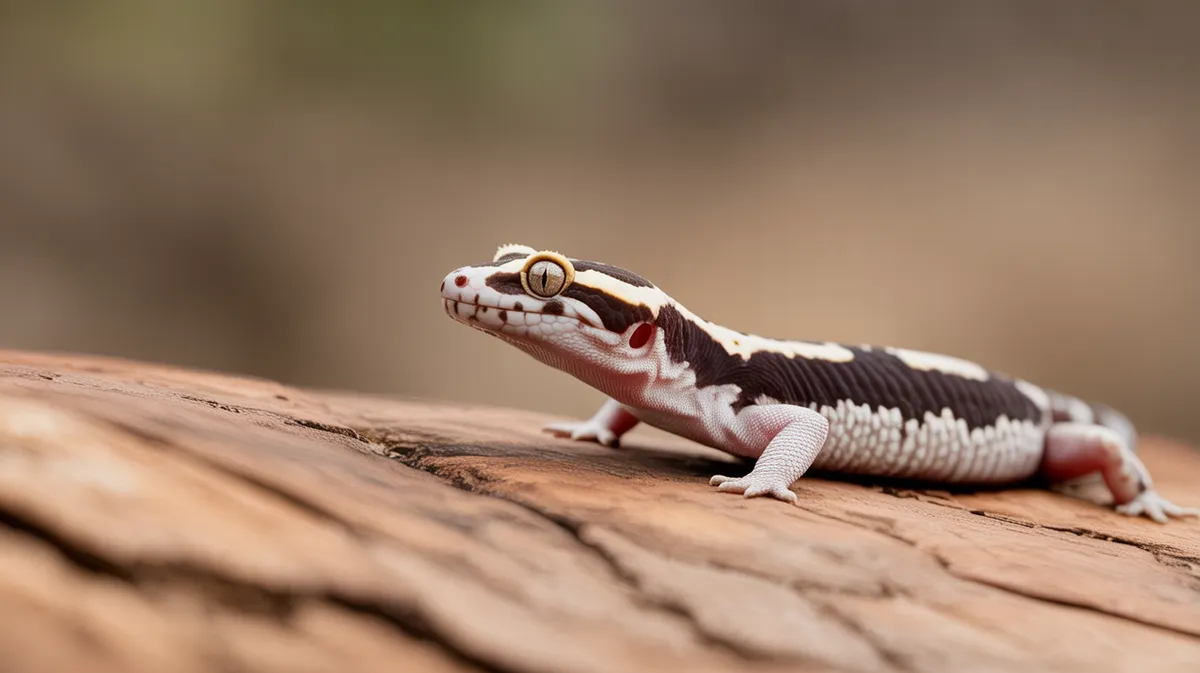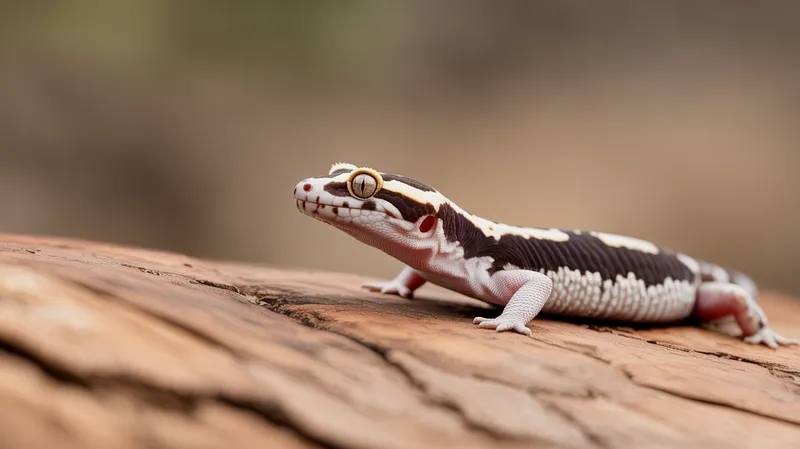
African Fat-tailed Gecko
Hemitheconyx caudicinctus

Meet the African Fat-tailed Gecko
The African Fat-tailed Gecko is a medium-sized, nocturnal lizard native to West Africa. Recognized for its distinctive broad tail, which stores fat as an energy reserve, this gecko displays earthy color patterns with bold stripes or bands. It prefers arid to semi-arid environments, often sheltering under rocks or in burrows to avoid the harshest heat. Calm and docile, the African Fat-tailed Gecko is a popular choice for reptile enthusiasts due to its manageable size and hardy nature.
Classification
Reptile
Habitat
Semi-arid savannas and dry forests
Diet
Carnivore
Lifespan
10-15 years
Conservation
Least Concern
Weight
45-75 grams
📖Fascinating Facts
Movable Eyelids
African Fat-tailed Geckos possess movable eyelids, a rare trait among gecko species, allowing them to blink and keep their eyes clean.
Tail Storage
Their thick tails act as fat storage, providing essential nutrients and energy during periods of food scarcity.
Nocturnal Lifestyle
These geckos are primarily active at night, hunting insects and avoiding the daytime heat.
📋Detailed Description
The African Fat-tailed Gecko (Hemitheconyx caudicinctus) is a robust, medium-sized lizard, typically reaching 18–23 cm (7–9 inches) in total length, with females generally smaller than males. Its most distinctive feature is the thick, bulbous tail, which serves as a fat storage organ, allowing the gecko to survive periods of food scarcity. The body is covered in smooth, granular scales, and its coloration ranges from earthy browns and tans to cream, often adorned with bold, contrasting bands or stripes and sometimes a prominent white dorsal stripe. The species exhibits vertical pupils, an adaptation for nocturnal activity, and lacks adhesive toe pads, unlike many other geckos, relying instead on strong claws for digging and climbing. African Fat-tailed Geckos are primarily terrestrial and secretive, spending daylight hours hidden in burrows, under rocks, or within leaf litter to avoid dehydration and predation. Their calm temperament and relatively slow movements contrast with the more skittish behavior of many other gecko species. They possess the ability to autotomize (shed) their tail as a defense mechanism, which can later regenerate, though the new tail is often shorter and differently shaped. This gecko is solitary outside of the breeding season, and its vocalizations are limited to quiet chirps or squeaks, usually during social interactions or when threatened. The species is well-adapted to the semi-arid environments of West Africa, thriving in microhabitats with moderate humidity and seasonal temperature fluctuations.
💡 Did you know?
If threatened, the African Fat-tailed Gecko can detach its tail, which continues to wriggle and distract predators, giving the gecko a chance to escape.
🔬Research & Sources
🎭Behavior & Social Structure
African Fat-tailed Geckos are strictly nocturnal, emerging from their shelters at dusk to hunt and explore. Their foraging behavior is characterized by slow, deliberate movements, using their keen sense of smell and vision to locate prey such as insects, spiders, and other small invertebrates. They are ambush predators, often waiting motionless before striking quickly at passing prey. In captivity, they readily accept crickets, mealworms, and roaches. Socially, they are solitary and territorial, with males displaying increased aggression toward other males, especially during the breeding season. Females may tolerate each other in overlapping territories, but crowding can lead to stress and competition. During the day, they remain inactive, conserving moisture and energy, and are known to dig shallow burrows or use abandoned rodent holes for shelter. When threatened, they may vocalize, flatten their bodies, or perform a tail-waving display to distract predators before fleeing or dropping their tail.
👶Reproduction & Life Cycle
Breeding in Hemitheconyx caudicinctus typically coincides with the onset of the rainy season (May to September), when environmental humidity and food availability increase. Males court females through tactile stimulation and gentle biting. After successful copulation, females lay clutches of 1–2 leathery eggs, often in moist, concealed locations such as under logs or within burrows. Females can produce multiple clutches per season, with intervals of 3–4 weeks between layings. The incubation period ranges from 45 to 70 days, depending on temperature and humidity, with optimal development occurring at 28–31°C (82–88°F). There is no parental care post-oviposition; hatchlings are fully independent and begin feeding shortly after their first shed. Temperature-dependent sex determination has been observed, with higher incubation temperatures favoring the development of females.
🛡️Adaptations & Survival
Key adaptations of the African Fat-tailed Gecko include its fat-storing tail, which provides an energy reserve during periods of food scarcity or drought. Its cryptic coloration and banding offer effective camouflage against the substrate, aiding in predator avoidance. The gecko's vertical pupils enhance night vision, while its lack of adhesive toe pads is compensated by strong, clawed digits suited for digging and terrestrial locomotion. The ability to autotomize the tail is a crucial anti-predator adaptation, as the detached tail continues to wriggle, distracting predators and allowing the gecko to escape. Behavioral adaptations include burrowing and seeking shelter to maintain hydration and avoid extreme temperatures. The species also exhibits a low metabolic rate, which reduces water and energy requirements.
📚Research Sources
🎨Cultural Significance
There is limited documented cultural significance of Hemitheconyx caudicinctus in indigenous West African societies. Unlike some gecko species, it does not feature prominently in local folklore or traditional medicine. However, in modern times, the species has gained popularity in the global pet trade due to its docile nature and ease of care, contributing to educational outreach and reptile conservation awareness. In some regions, geckos in general are considered beneficial for controlling insect populations.
🔬Recent Research & Discoveries
Recent research has focused on the species' reproductive biology, particularly temperature-dependent sex determination and its implications for population dynamics under climate change. Studies on tail autotomy have provided insights into regenerative processes and the trade-offs between energy storage and predator defense. Genetic analyses have revealed significant intraspecific variation across the species' range, suggesting possible cryptic diversity. Ongoing field studies are examining the impact of habitat fragmentation and the sustainability of wild harvest for the pet trade. Captive breeding programs have been successful, reducing pressure on wild populations and providing opportunities for further behavioral and physiological research.
🎥Wildlife Videos

FAT-TAILED GECKOS IN THE WILD! (Are we keeping them correctly?)
African fat-tailed geckos, like leopard geckos, are one of the most popular pet lizards and in this video, I head into the wilds of ...
Dāv Kaufman's Reptile Adventures

Fat-Tailed Gecko: Zilla Beyond the Glass -- Season 2, Episode 3
Tonight, we head into the savanna after dark, where Myke and the team are on the look out for Fat-Tailed Geckos. The night ...
Zilla

Why Exotic African Fat-Tailed NOT a Lizard?
Enjoy some dope facts about the African fat tailed gecko's bioactive nature. OR an African fat tailed geckos tank setup. AND some ...
Dope Animals

African Fat Tail Gecko Pros & Cons
Subscribe to my channel for more videos! I post every couple days! :) Please check out Zen Habitats here: ...
Reptilian Garden

Top 5 Wild Species Of Leopard Gecko | Giant Eublepharis
Today we'll be taking a closer look at the Eublepharis species as a whole. Eublepharis are Leopard Geckos, but within that group ...
Leopard Gecko

Slime Squirts Out of This Gecko's Tail - Crazy Defence!
The Golden Tailed Gecko ( Strophurus taenicauda ) is found in the Brigalow region inland of Australia. This nocturnal species ...
Made in the Wild
🌍Habitat Information
The African Fat-tailed Gecko typically inhabits Semi-arid savannas and dry forests environments. African Fat-tailed Geckos have adapted to their environments with specialized features and behaviors.
Primary Habitat:
Semi-arid savannas and dry forests
More detailed habitat information will be available soon.
🛡️Conservation Status
The African Fat-tailed Gecko is currently classified as Least Concern. Conservation efforts are crucial for preserving this species for future generations.
Common Threats:
- 🏠Habitat loss and fragmentation
- 🌡️Climate change impacts
- 🎯Hunting and poaching
- 🏭Human-wildlife conflict
⚠️Threats & Conservation Challenges
Currently assessed as Least Concern by the IUCN, the African Fat-tailed Gecko faces localized threats from habitat degradation due to agricultural expansion, deforestation, and urbanization. Collection for the international pet trade, while regulated, can impact wild populations if not managed sustainably. Climate change poses a potential long-term threat by altering rainfall patterns and habitat suitability. Despite these pressures, the species remains widespread and relatively abundant across its range, with stable population trends in most areas. Conservation challenges include the need for habitat protection, monitoring of trade, and public education to prevent over-collection.
🔬Scientific Classification
Scientific Name
Hemitheconyx caudicinctus
Classification Hierarchy
🔍 About Taxonomic Classification
Taxonomic classification is a hierarchical system used by scientists to classify and organize living organisms based on shared characteristics and evolutionary relationships.
The system moves from broad categories (Kingdom) to increasingly specific ones, with each animal's scientific name typically consisting of its Genus and species.
📝Community Notes
Share your observations and insights about the African Fat-tailed Gecko with our community of wildlife enthusiasts.
Join Our Community
Sign in to share your observations and connect with fellow wildlife enthusiasts.
Sign In to ContributeNo community notes yet
Be the first to share your observations about the African Fat-tailed Gecko!
Explore African Fat-tailed Gecko
Select a tab above to learn more about this amazing animal.
📸Photo Gallery
No photos available for this animal yet.
🌟Discover More Wildlife
Continue your journey of discovery with more fascinating animals from our database
